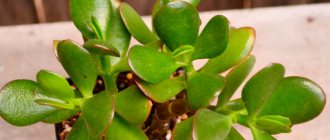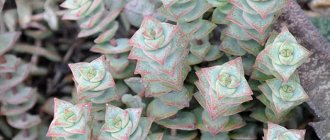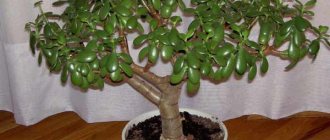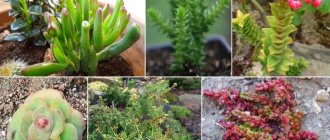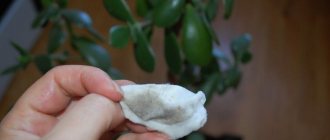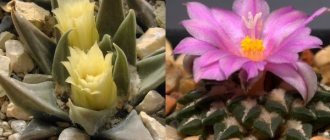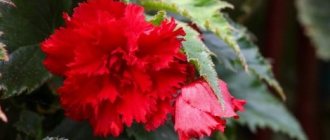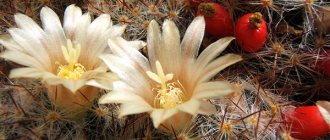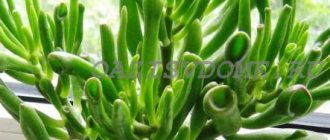International name:
Synonyms:
Characteristics:
| Complexity: |
| Development cycle: |
| Light mode: |
| Watering mode: |
| Temperature: |
| The soil: |
| Key Feature: |
Foliage color
Bud color
Dimensions Flower sizes
Taxonomy:
| Domain: |
| Kingdom: |
| Department: |
| Class: |
| Order: |
| Family: |
| Genus: |
Native to South Africa, Crassula Perforata is also known as the Vine Necklace or Button String. This attractive succulent has leaves stacked on top of each other and spreads out in all directions.
The small, dense leaves form a tight spiral around the stem. They have a pale bluish-green hue as well as reddish-pink edges that become brighter when exposed to plenty of sunlight.
Description and characteristics
Crassula perforata is a perennial plant reaching 3-4 meters in height. Shoots of this species die off after fruiting (except for the basal part, on which renewing buds are located). The flowers are small, whitish or yellow. In rare cases there are red and blue. Usually five-membered, but there are also single axillary ones. They are located in terminal or lateral paniculate-umbellate or racemose inflorescences.
The stamens are represented by opposite petals. The anther is ovoid or oblong. Nectar scales are small. Carpels are free or growing from the base. The ovary is longer than the style. Crassula perforatum grows primarily in South Africa and Madagascar in thicket vegetation and rocky slopes from Worcester in the west to the far east of KwaZulu-Natal.
Reference. Crassula perforata is also found in southern Arabia.
Crassula perforata grows with unbranched, long and wandering stems, not reaching a length of 20 cm. It has a thick and long trunk, on which are round and fleshy leaves with a pronounced bluish bloom. They have opposite layered leaf arrangement.
In bright sunlight, the edges of the leaves become reddish.
Crassula perforatum is an unpretentious flower. If you do not set out to get flowers, then it is enough to follow the rules of watering and plenty of daylight. Crassula quickly takes root and reproduces. Flowering requires low temperatures (10 – 12°C) and limited watering. The fat woman is a long-liver; with proper care, she will live at least 15 years.
Crassula ovata The Hobbit
The extensive Crassula family was replenished with a new variety of Crassula Hobbit in the middle of the last century. The flower is attractive not only for its ease of care, but also for its unusual appearance.
Crassula the Hobbit - an unusual succulent
Description
The peculiarity of the plant is the unusual shape of the leaves. Unlike ordinary Crassula, they are not round, but elongated. The edge of the leaf plate resembles a funnel, which is framed by a thin reddish border.
The shape of the flower resembles a small tree with fleshy and powerful stems and lush green leaves. In older specimens, the trunk may become partially woody. Crassula flowers are inconspicuous, small and have a pale pink tint. In indoor conditions they appear very rarely.
Origin story
Crassula Hobbit (crassula ovata hobbit) appeared thanks to the work of American breeders in the 70s of the last century. By crossing the Ovata and Molochnaya varieties, it was possible to obtain a new interesting species. The flower received its name due to the publication of Tolkien’s work “The Lord of the Rings”.
During the crossing experiment, another species was obtained - Crassula gollum. Externally, the plants are similar, but their leaf shapes are different. Crassula Hobbit has funnel-shaped leaves, fused only at the base, while Crassula Gollum has leaves fused along the entire length and widened towards the edge. There is an even later species that is similar in appearance to both of the above - Crassula Coral.
Crassula Gollum is very similar to the Hobbit variety
What varieties exist in this species: description and photo
Variegata
Crassula Variegata is a perennial, creeping plant with a branched stem reaching 60 cm in length. It has dark green shiny leaves, about 3-4 cm in length. Petiolate leaf arrangement. As you can see in the photo, the flowers are single, mostly blue. Fruits are rarely produced; vegetative propagation predominates through branching of rhizomes and pruning of shoots.
Important! Does not tolerate hot places, prefers shade and partial shade.
Minor
Crassula Minor is a fastidious and slow-growing plant. It grows as a compact and small bush. The color of the leaves ranges from light red, which turns into dark red during the life of the plant. The leaves are fleshy, shiny, green in color with a reddish edge, reaching 4 cm in length.
Alba
The leaves of Crassula Alba are oblong, shiny, smooth and without plaque. On average, the leaf length reaches 5-6 cm in length. The leaf color is reddish with a cream pattern, but green with a burgundy pattern is also found. The stem is shortened, but during the development of the peduncle they stretch 30-40 cm. Alba's leaf arrangement is a basal rosette.
Attention! During flowering, the rosette dries out - this is a feature of this variety.
Crassula ovata The Hobbit
The extensive Crassula family was replenished with a new variety of Crassula Hobbit in the middle of the last century. The flower is attractive not only for its ease of care, but also for its unusual appearance.
Crassula the Hobbit - an unusual succulent
Description
The peculiarity of the plant is the unusual shape of the leaves. Unlike ordinary Crassula, they are not round, but elongated. The edge of the leaf plate resembles a funnel, which is framed by a thin reddish border.
The shape of the flower resembles a small tree with fleshy and powerful stems and lush green leaves. In older specimens, the trunk may become partially woody. Crassula flowers are inconspicuous, small and have a pale pink tint. In indoor conditions they appear very rarely.
History of appearance
A flower that looks like a coral reef appeared on the windowsills of amateur gardeners thanks to breeders from the USA in the mid-70s. last century. The basis for breeding a new species was Crassula Lactea, or, as the common people say, milky. As it grows, the bush with succulent leaves turns into a tree due to lignification of the branches and trunk. In nature it can grow up to two meters. At home it reaches 80 cm.
Crassula the Hobbit got its name due to its resemblance to the ears of Shrek, the cartoon character
For your information! Crassula the Hobbit and Crassula Gollum at first glance are very similar to each other, but there are still differences. Gollum differs in leaf shape, has small extensions at the tips that form a calyx, and grows slightly slower than its relative.
Home care
| Lighting | Crassula perforata is located so that there is enough sunlight. But it is worth protecting the plant from direct sunlight, as it can cause burns, especially for young plants. |
| Temperature | In spring and summer, room temperature (20 – 23°C) is sufficient, but in autumn and winter the pot should be moved to a cool place (10 – 12°C). At night, the optimal temperature will be 12 – 14°C, in any season of the year. |
| Location | The plant should be placed on the east and southwest sides, and if all the windows in your apartment face the south, shade them with light protection. In summer, it is allowed to take the plant out onto the balcony. |
| Watering | Requires moderate watering. It will be enough once a week in the summer, and once every two weeks in the winter. Between waterings, the soil should dry out ≈ 3 cm deep. If water appears in the pan after watering, it must be drained. Stagnation of water is unacceptable. |
| Air humidity |
|
| Top dressing | At the beginning of spring, you can fertilize the plant with liquid mineral fertilizer for cacti and succulents, because they have a high content of potassium and phosphorus. For young plants, you can use nitrogen fertilizer in low concentration. It will stimulate the growth of leaves and stems. |
The soil should be light and peat-free. Drainage is also important; it must be tight. Approximate soil composition:
| |
| Trimming | In order for the plant to take on a bushy appearance, the tops of young stems (2–3 leaves) should be trimmed weekly. Apical cuttings can be rooted. |
| Diseases and pests |
To prevent the appearance of diseases and pests, use a weak solution of potassium permanganate. |
Brief rules for growing philodendron
Crassula, money tree, or crassula: the best types and varieties
The table provides brief rules for caring for philodendron at home.
Lighting level Plants prefer diffused lighting, but are afraid of direct rays. Maintenance temperature The most comfortable conditions for growing a bush are considered to be 20-25 degrees
In winter it should not be colder than 15 degrees. Watering regime The plant requires regular watering, especially during the period of most active growth - in spring and summer. Air humidity The plant needs regular spraying, which is especially important during the heating season. Soil Suitable for growing is nutritious, but light and breathable soil with a slightly acidic reaction. You can use ready-made orchid substrates for them. Feeding At home, plants should be fed during the period of their active development - from March to the end of August once every couple of weeks. Transplantation Until the bushes reach maturity, they are replanted annually
Adult plants are moved 2-3 times less often. Dormant period The dormant period occurs in winter, but is weakly manifested. Reproduction Seeds, as well as parts of the bush - cuttings, layering, leaves, sections of the trunk or tips of the shoots. Pests Thrips, spider mites, scale insects. Diseases Can be susceptible to various diseases just due to improper care.
Features of Crassula perforatum
There are three breeding options for Crassula.
Cuttings (shoots)
It is recommended to carry out cuttings of Crassula in the spring, during the activation of plant growth.
Rooting cuttings in the ground:
- Select strong cuttings with small leaves that reach at least 10 cm in length and cut them with a sharp knife.
- Treat the cutting with charcoal and leave it in the open air for a day.
- Place the shoot in a pot filled with loose soil, sprinkle the trunk, but do not compact it.
- Moisten the soil with a spray bottle.
Rooting leaves
Rooting leaves in water:
- Fill a low container with root stimulant solution.
- Cut the edge of the sheet and lower it 5 mm into the solution.
- When the first roots appear, plant the plant in a small container, and later in a pot with a diameter of no more than 7 cm.
Reference. During rooting of leaves, avoid direct sunlight!
Propagation by seeds
- The pot is filled with a soil mixture: 1 part leaf soil, 0.5 parts sand.
- The entire surface of the soil is covered with Crassula seeds and sprinkled with sand.
- The soil is moistened and covered with glass.
- Plantings are ventilated daily.
Reproduction
Seeds
- Seeds are sown in flat, wide containers, in a mixture of sand and leaf soil (1:2).
- The crops are kept under film and ventilated daily.
- Seedlings sprout after 2 weeks.
- Grown-up seedlings are planted in small pots with a diameter of 6–7 cm for growth.
Cuttings and leaves
The most reliable and affordable way.
- The shoots are cut out with a knife, the leaves are carefully broken off.
- The fragments are dried for 2 days in the shade and treated with crushed coal.
- You can root in a mixture of sand and leaf soil or in water with the addition of activated carbon (1 tablet per glass of water). After the roots appear, the seedlings are transferred to separate containers.
Care as for adult plants.
Important: Crassula perforatum can be propagated at any time of the year; usually the procedure is carried out in the spring.
We invite you to watch a video about propagating Crassula by cuttings:
What plants are similar to Crassula perforata?
- Graptopetalum paraguayense (Paraguayan Graptopetalum) - like Crassula Perforata, has diamond-shaped, fleshy and green leaves.
- Aichryson x domesticum (Aichryson home) - similar in leaves, size of the formed bushes, as well as a hybrid variety.
- Monanthes muralis (Monanthes wall) - succulent, green leaves, about 3 cm in length.
- Monanthes amydros (Monanthes amydros) - racemose inflorescences, evergreen leaves.
- Graptopetalum paraguayense (Paraguayan graptopetalum) - the leaves are covered with bluish wax, has a short and succulent stem.
Caring for a fat woman is not difficult. If you follow all the rules, then this plant will give you good growth, a beautiful appearance, and will also bring a lot of joy and decorate any interior. We invite you to learn how to grow such types of Crassula as Tree, Pursula, Sunset, Moss, Silver, Buddha Temple, Ovata, Hobbit and Gollum.
In conclusion, it is worth noting that in addition to its unusual appearance, unpretentiousness, longevity and ease of care, Crassula is widely used in medicine as an antimicrobial and antiviral agent.
Varieties of Crassula perforata
Two common varieties of Perforata can be easily found in garden centers and online. Let us describe their features.
Crassula perforata variegata
The epithet Variegata (“variegated”) refers to the presence of different colors of leaves. This variety has a variety of colors ranging from green to yellow and pink.
Some have rainbow edges while others have stripes.
Landing
When planting Crassula "Hobbit", special attention should be paid to preparing the substrate and choosing a pot. You can pick up the soil mixture at the store. It is better to stay with a composition intended for cacti and succulents
However, you can make the substrate yourself from available components. You need to take:
It is better to stay with a composition intended for cacti and succulents. However, you can make the substrate yourself from available components. You need to take:
- 1 part sheet soil;
- 1 part river sand;
- 1 part turf.
All components can be assembled in an environmentally safe place away from major roads and highways. It is also necessary to add a little crushed coal, zeolite and fine expanded clay to the prepared mixture. All components must first be calcined on a baking sheet in the oven - this will destroy the larvae of insect pests, as well as pathogens of fungal, viral and bacterial infections.
You should definitely put drainage at the bottom of the container; it should occupy at least a third of the pot. Usually pebbles or expanded clay are used
This is very important, since stagnation of water leads to waterlogging of the soil, and this has the most detrimental effect on the condition of the root system and leads to the shedding of leaves
The root system of Crassula is superficial, so it is better to choose a low, but wide and flat pot for the plant. It is in such a container that the fat woman will be as comfortable as possible. The diameter of the pot should approximately correspond to the size of the crown. If it is smaller, the roots will be cramped. If you take a larger pot, the Crassula will grow and develop very slowly.
The container can be made of any material, but since the flower looks very impressive and resembles a bonsai, it will look best in a ceramic or clay container. If you wish, you can even choose a special bonsai
There is also one important requirement for Crassula pots - they must have several drainage holes to remove excess moisture from the substrate

